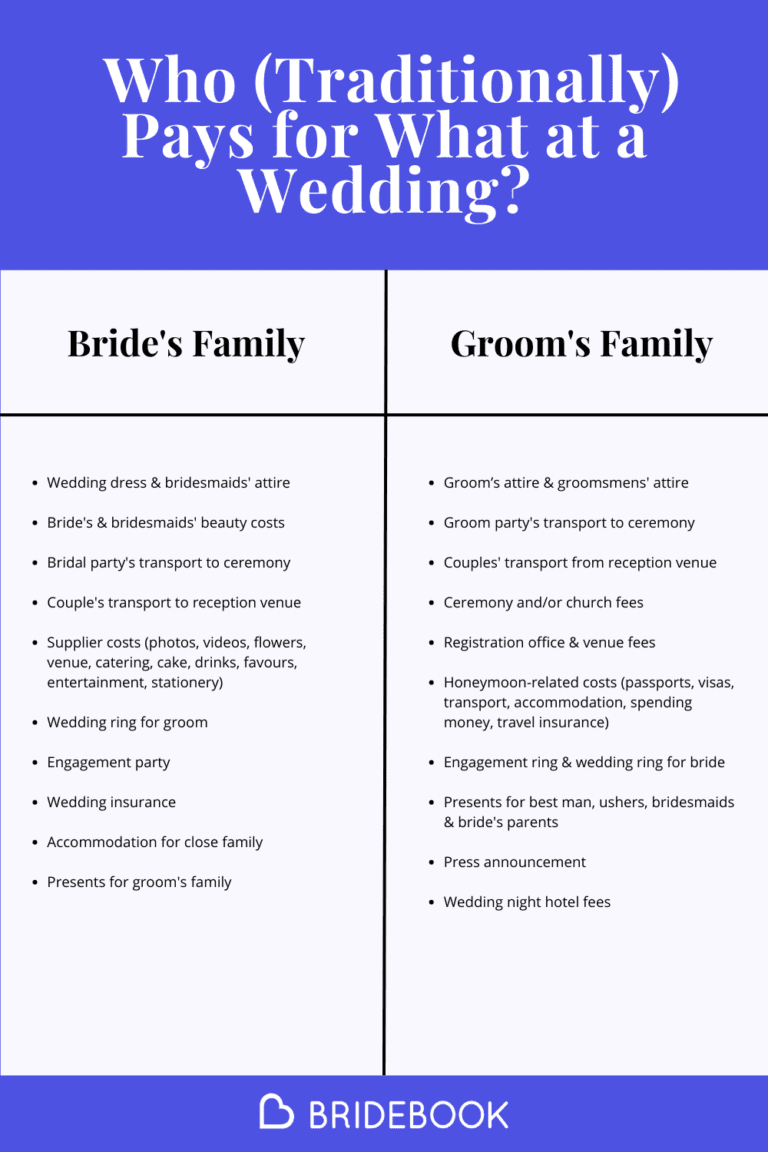The Bride’s Family Has Historically Covered Wedding Costs
Traditionally, the bride’s family pays for the wedding dress and many other wedding expenses. This custom dates back centuries to when weddings were arranged by families to secure social and financial alliances. Since the bride’s family benefited, they covered the costs. Over time, cultural norms shifted towards romantic love matches, but the tradition of the bride’s family paying persisted.

Why Do Brides’ Families Pay?
There are a few reasons this tradition continues today:
- The wedding is seen as more meaningful to the bride since it signifies leaving her childhood family. Paying for expenses is a way for her family to contribute.
- Women used to have limited financial independence, so the bride was rarely expected to pay her own expenses.
- It can be meaningful for parents to provide this gift to their daughter before she begins her new family.
Modern Couples Cover More Costs
While the tradition continues in many families, contemporary couples contribute more to wedding expenses today. Some reasons for this shift:
- Couples often pay for parts or all of the wedding themselves to have more control over decisions.
- With more equitable gender norms, both spouses are expected to manage finances.
- Couples often live together before marriage or pay other shared expenses, so they may split costs.
How Modern Couples Decide
Today’s couples take different approaches to paying for the dress and other wedding costs:
- Split expenses: The most common approach is to split wedding costs proportionally based on income. For example, one partner may pay for the venue and food while the other covers the dress and photography.
- Pay their own way: Some egalitarian couples expect each partner to cover their own personal expenses, like attire, even if one family contributes more overall.
- Stick to tradition: If one family volunteers to pay for the event per tradition, the couple may accept while covering other items like rings.
Who Pays For Specific Items
While practices vary by culture and preference, here are some common norms around paying for wedding elements:
The Wedding Dress
Wedding gowns can cost anywhere from $500 to over $10,000. Since it’s exclusively for the bride, tradition holds that her family should cover this expense as their key contribution.
Tuxedo Rental
If the groom needs formalwear, he would traditionally cover the tuxedo rental himself. However, his parents, the bride’s family, or the couple may share this cost as well.
Rings
The wedding rings are exchanged between the couple, so they typically expect to split this expense or pay individually. However, parents sometimes contribute as the gift.
Ceremony Venue
The ceremony venue rental fee is often covered by the families together or solely by the bride’s parents. The couple usually pays if they host a smaller, more casual wedding.
Catering or Dinner
Paying for the wedding reception food and drink is now seen as a shared expense. The couple or both families can contribute based on their budgets and preferences.
Who Helps With Expenses
Beyond the couple and their immediate families, here are some other family members or parties who may help cover wedding costs as a gift:
- Grandparents on either side
- Aunts/uncles
- Siblings or members of the wedding party
- Friends or other relatives as a wedding gift
Creating a Budget
To decide who pays for what, experts recommend couples have an open discussion about their budgets and financial constraints. This allows them to set shared priorities and allocate specific items to the bride, groom, or their families.
Websites like The Knot provide budget calculators couples can use to tally expenses, assign items, and communicate needs clearly to family members. Tracking expenses this way helps prevent sticker shock down the road.
Asking Family To Contribute
If couples hope for financial help from family, etiquette calls for making these requests tactfully. Rather than demanding money, it works better to:
- Give family a complete budget upfront so they can volunteer what they can afford.
- Frame any requests as “asking for help” rather than expecting it.
- Show appreciation for any generosity and avoid pressuring relatives if they can’t pay.
- Consider paying back parents if they contribute beyond their means.
Who Pays When Parents Can’t Help
These days, couples often pay for most or all of the wedding themselves if parents don’t have the means. Some options to cut costs include:
- Having a small, informal wedding.
- Hosting the reception at an affordable restaurant instead of a venue.
- Asking for cash gifts to help offset big-ticket items.
- Getting a wedding dress online for hundreds less.
The important thing is for couples to communicate openly and scale expenses based on their collective resources. Traditions can serve as a guideline, but practicality and compromise should rule the day.



